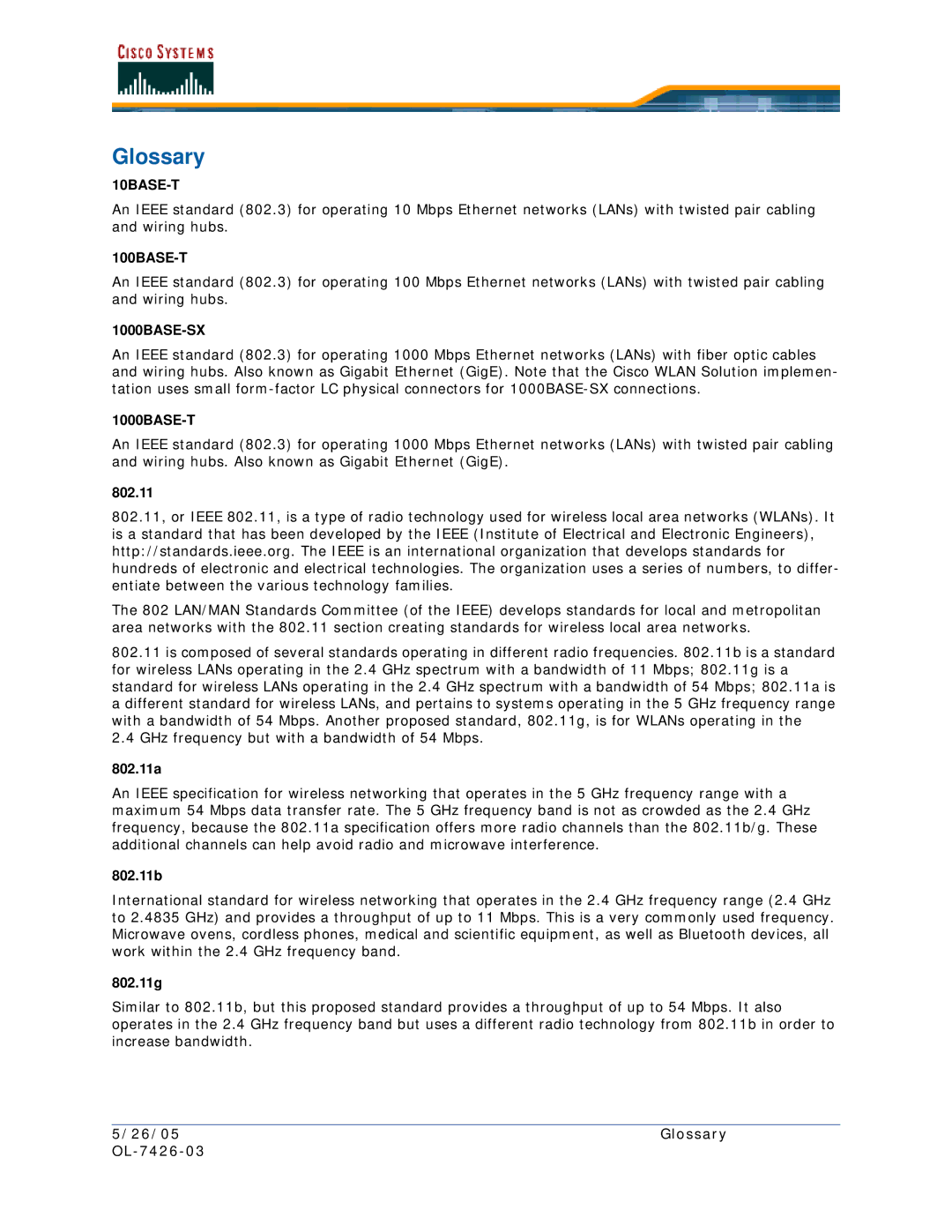
Glossary
10BASE-T
An IEEE standard (802.3) for operating 10 Mbps Ethernet networks (LANs) with twisted pair cabling and wiring hubs.
100BASE-T
An IEEE standard (802.3) for operating 100 Mbps Ethernet networks (LANs) with twisted pair cabling and wiring hubs.
1000BASE-SX
An IEEE standard (802.3) for operating 1000 Mbps Ethernet networks (LANs) with fiber optic cables and wiring hubs. Also known as Gigabit Ethernet (GigE). Note that the Cisco WLAN Solution implemen- tation uses small
1000BASE-T
An IEEE standard (802.3) for operating 1000 Mbps Ethernet networks (LANs) with twisted pair cabling and wiring hubs. Also known as Gigabit Ethernet (GigE).
802.11
802.11, or IEEE 802.11, is a type of radio technology used for wireless local area networks (WLANs). It is a standard that has been developed by the IEEE (Institute of Electrical and Electronic Engineers), http://standards.ieee.org. The IEEE is an international organization that develops standards for hundreds of electronic and electrical technologies. The organization uses a series of numbers, to differ- entiate between the various technology families.
The 802 LAN/MAN Standards Committee (of the IEEE) develops standards for local and metropolitan area networks with the 802.11 section creating standards for wireless local area networks.
802.11is composed of several standards operating in different radio frequencies. 802.11b is a standard for wireless LANs operating in the 2.4 GHz spectrum with a bandwidth of 11 Mbps; 802.11g is a standard for wireless LANs operating in the 2.4 GHz spectrum with a bandwidth of 54 Mbps; 802.11a is a different standard for wireless LANs, and pertains to systems operating in the 5 GHz frequency range with a bandwidth of 54 Mbps. Another proposed standard, 802.11g, is for WLANs operating in the
2.4GHz frequency but with a bandwidth of 54 Mbps.
802.11a
An IEEE specification for wireless networking that operates in the 5 GHz frequency range with a maximum 54 Mbps data transfer rate. The 5 GHz frequency band is not as crowded as the 2.4 GHz frequency, because the 802.11a specification offers more radio channels than the 802.11b/g. These additional channels can help avoid radio and microwave interference.
802.11b
International standard for wireless networking that operates in the 2.4 GHz frequency range (2.4 GHz to 2.4835 GHz) and provides a throughput of up to 11 Mbps. This is a very commonly used frequency. Microwave ovens, cordless phones, medical and scientific equipment, as well as Bluetooth devices, all work within the 2.4 GHz frequency band.
802.11g
Similar to 802.11b, but this proposed standard provides a throughput of up to 54 Mbps. It also operates in the 2.4 GHz frequency band but uses a different radio technology from 802.11b in order to increase bandwidth.
5/26/05 | Glossary |
|
|
